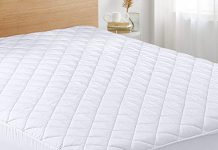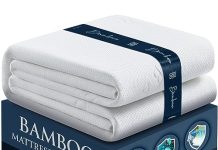Cleaning a duvet can be quite the challenge, especially if you’ve never done it before. But fear not, because we’ve got you covered! In this article, we’ll share some handy tips and tricks on how to properly clean a duvet. From choosing the right cleaning method to tackling tough stains, we’ve got all the information you need to keep your duvet fresh and cozy. So, let’s roll up our sleeves and get ready to learn the secrets of duvet cleaning! Cleaning a duvet may seem like a daunting task, but with the right techniques and a little care, it can be easily done. In this article, we will guide you through the step-by-step process of properly cleaning a duvet to ensure it stays fresh, clean, and cozy. So, let’s jump right in!
Review contents
Preparation
Check the care label
Before embarking on the cleaning process, it is essential to check the care label on your duvet. Different types of duvets require different cleaning methods, so it’s important to follow the instructions provided by the manufacturer. The care label will provide guidance on whether the duvet can be machine washed, hand washed, or if it requires professional cleaning.
Remove the duvet cover
The first step in cleaning your duvet is to remove the duvet cover. This allows for easier cleaning and prevents any potential damage to the delicate fabric of the cover. Simply unzip or unbutton the cover and gently slide it off the duvet.
Inspect for stains or damage
Before proceeding with the cleaning process, take a few moments to carefully inspect the duvet for any stains or damage. If you spot any stains, it’s important to address them before washing to prevent setting them further into the fabric. Also, make sure there are no tears, holes, or loose threads that need mending. By addressing these issues beforehand, you can ensure a thorough and effective cleaning process.
Duvet Cover Cleaning
Machine wash on gentle cycle
If your duvet cover is machine washable, it is generally safe to clean it in a washing machine. However, it is essential to use the gentle cycle to minimize any potential damage or shrinkage. This gentle cycle will provide a delicate yet thorough cleaning for your duvet cover, keeping it in good condition for long-lasting use.
Use mild detergent
When washing your duvet cover, it’s important to use a mild detergent specifically designed for delicate fabrics. Harsh detergents can strip the fabric of its natural oils and cause it to become stiff or lose its softness. Opt for a mild detergent that is suitable for the specific fabric composition of your duvet cover.
Dry on low heat or air dry
Once the duvet cover has been washed, it’s time to dry it properly. Depending on the specific care instructions, you can either choose to tumble dry the duvet cover on low heat or air dry it. Tumble drying on low heat is a quicker option, but air drying helps maintain the fabric’s quality and prevents any potential shrinkage. Whichever method you choose, make sure the duvet cover is completely dry before using or storing it.
Spot Cleaning
Identify the stain
Spot cleaning is a great solution for small stains that don’t require a full wash. Start by identifying the type of stain you are dealing with. Whether it’s a food stain, makeup stain, or any other type, understanding the stain’s nature will help you choose the appropriate cleaner and technique.
Treat the stain with appropriate cleaner
Once you have identified the stain, it’s time to treat it with an appropriate cleaner. There are numerous stain removers available on the market, each designed to tackle specific types of stains. Follow the instructions on the cleaner, apply it to the stain, and let it sit for the recommended amount of time to effectively break down and lift the stain.
Blot the stain with a clean cloth
After treating the stain, gently blot it with a clean cloth. Avoid rubbing the stain vigorously, as this can spread the stain further and potentially damage the fabric. Blotting helps absorb the stain and cleaner, ensuring that it is effectively removed from the duvet. Continue blotting until the stain is no longer visible, and then allow the spot to air dry.
Hand Washing
Fill a bathtub or large basin with lukewarm water
Hand washing is a suitable option for duvets that cannot be machine washed or for those who prefer a more hands-on approach. To start, fill a bathtub or large basin with lukewarm water. The water should be at a comfortable temperature that won’t damage the fabric or alter its shape.
Add gentle detergent and mix well
Next, add a gentle detergent suitable for hand washing to the water. Gently mix the water and detergent until they are well combined. Avoid using harsh detergents that can strip the fabric of its natural oils or cause any potential damage.
Submerge the duvet and gently agitate
Once the detergent is mixed into the water, it’s time to submerge the duvet and gently agitate it. Gently knead and press the duvet to ensure that the detergent is evenly distributed and able to penetrate the fabric. Avoid excessive agitation or wringing, as this can damage the duvet’s filling or fabric. After a few minutes of gentle agitation, drain the soapy water.
Machine Washing
Use a large front-loading machine
For duvets that can be safely machine washed, it’s important to use a large front-loading machine. Top-loading machines can agitate the duvet too aggressively and potentially damage the filling or fabric. A front-loading machine provides a more gentle washing action, ensuring a proper and thorough cleaning without compromising the duvet’s integrity.
Add detergent and set a gentle cycle
Before loading the duvet into the machine, add the appropriate amount of mild detergent. Use a gentle cycle setting to minimize any potential damage. This gentle cycle will help maintain the duvet’s shape and fluffiness while effectively cleaning it.
Ensure the duvet isn’t tightly packed
To ensure proper cleaning, make sure the duvet isn’t tightly packed in the machine. The duvet needs room to move freely in the machine to allow for thorough cleaning. Avoid overloading the machine, as this can result in an uneven cleaning process and potentially damage the duvet or the machine.
Drying
Choose low heat or air dry
Once the cleaning cycle is complete, it’s time to dry the duvet. Choose a drying method that suits the instructions provided by the duvet’s care label. If tumble drying is allowed, select the low heat setting to prevent any potential damage, shrinkage, or overheating. Alternatively, opt for air drying to maintain the duvet’s quality and prevent excessive heat exposure.
Fluff the duvet periodically during drying
During the drying process, it’s important to periodically fluff the duvet. This helps redistribute the filling and prevents it from clumping together or settling in certain areas. Gently shake and fluff the duvet every now and then to ensure it dries evenly and maintains its loftiness.
Ensure the duvet is completely dry before use
Before using or storing the duvet, make sure it is completely dry. Even a slightly damp duvet can lead to unpleasant odors or potential mold growth. Take the time to ensure the duvet is thoroughly dry to avoid any moisture-related issues and to maintain its freshness.
Storage
Make sure the duvet is clean and completely dry
Before storing your duvet, ensure that it is clean and completely dry. Any residual moisture or dirt can lead to musty odors or potentially damage the fabric over time. Take the necessary steps to ensure your duvet is in its best possible condition before storing it.
Fold and place in a breathable storage bag
To protect your duvet while in storage, fold it neatly and place it in a breathable storage bag. Opt for cotton or linen bags that allow air circulation and prevent any potential moisture buildup. Avoid storing your duvet in plastic or airtight containers, as these can trap moisture and lead to mold or mildew growth.
Avoid storing in plastic or airtight containers
As mentioned earlier, it is important to avoid storing your duvet in plastic or airtight containers. These containers can create a humid environment that promotes the growth of mold or mildew. Opt for breathable storage options to ensure your duvet stays fresh and odor-free while in storage.
Professional Cleaning
Consider professional cleaning for delicate or oversized duvets
If you have a delicate or oversized duvet, it may be best to consider professional cleaning. Professional cleaners have the equipment, expertise, and specialized cleaning methods needed to safely and effectively clean these types of duvets. By entrusting your duvet to professionals, you can ensure it receives the appropriate care and attention it deserves.
Research local duvet cleaning services
When selecting a professional cleaning service, it’s important to research and choose a reputable provider. Look for local duvet cleaning services that have positive reviews and a proven track record of high-quality service. Reading customer testimonials and seeking recommendations from friends or family can help you make an informed decision.
Follow their specific instructions and care recommendations
Once you have chosen a professional cleaning service, it’s important to follow their specific instructions and care recommendations. Different cleaners may have different techniques or products they prefer to use. By communicating clearly and following their guidance, you can ensure your duvet receives the best possible care and cleaning.
Frequency of Cleaning
Clean the duvet at least twice a year
To maintain a fresh and clean duvet, it is recommended to clean it at least twice a year. Regular cleaning helps remove dirt, dust, and allergens that can accumulate over time. By incorporating duvet cleaning into your regular household cleaning routine, you can ensure a hygienic and comfortable sleep environment.
Increase frequency if it gets soiled or smells
In some cases, you may need to clean your duvet more frequently if it becomes soiled or starts to develop an unpleasant smell. Factors such as spills, accidents, or perspiration can cause a duvet to become dirty or smelly. Assess the condition of your duvet regularly and increase the frequency of cleaning as needed to maintain its cleanliness and freshness.
Special Considerations
Check for feather allergies before cleaning a down duvet
If you have a down duvet, it’s essential to check for any feather allergies before cleaning. Down can trigger allergies in some individuals, and direct contact with it during the cleaning process can cause discomfort and adverse reactions. If you or anyone in your household has known feather allergies, take appropriate precautions or consider alternative cleaning methods.
Follow alternative cleaning methods for wool or silk duvets
Wool and silk duvets require special care and unique cleaning methods. These delicate fabrics should be handled with extra caution to avoid damage or excessive shrinkage. Generally, it is recommended to follow the care instructions provided by the manufacturer or consult with a textile expert to ensure you’re using the appropriate cleaning techniques for these types of duvets.
Consult the manufacturer or a textile expert if unsure
If you ever feel unsure about the specific care requirements for your duvet or if you encounter any issues during the cleaning process, don’t hesitate to consult the manufacturer or a textile expert. They can provide valuable guidance, answer any questions you may have, and offer advice tailored to your specific duvet’s needs.
In conclusion, properly cleaning a duvet is essential to maintain its freshness, cleanliness, and overall comfort. By following the steps and tips outlined in this article, you can confidently and effectively clean your duvet, ensuring it remains cozy and inviting for many peaceful nights of sleep to come. Remember to check the care label, remove the duvet cover, inspect for stains or damage, and choose the appropriate cleaning method based on the type of duvet you have. With a little care and attention, your duvet will stay clean, fresh, and ready to provide warmth and comfort whenever you need it.


























